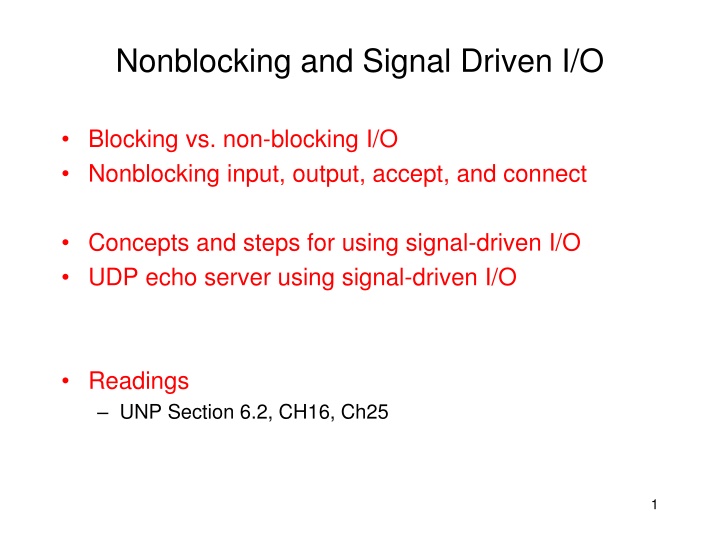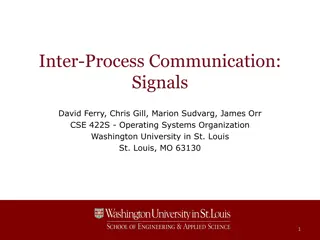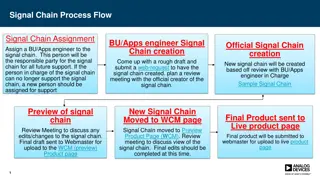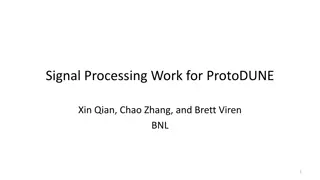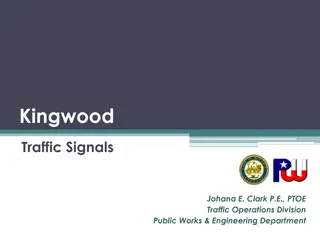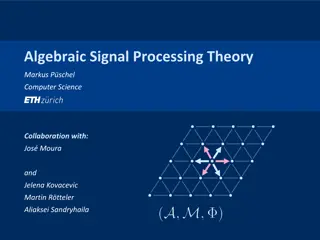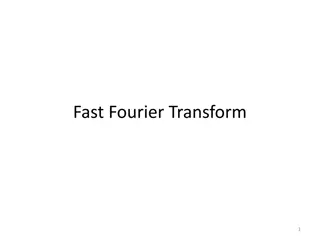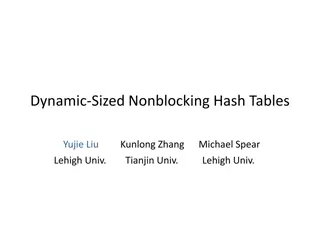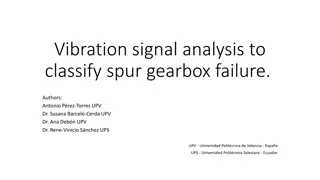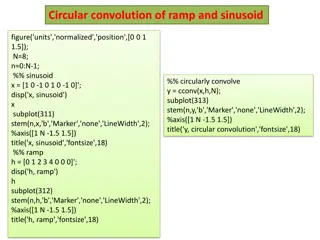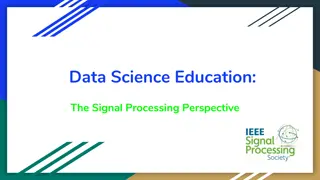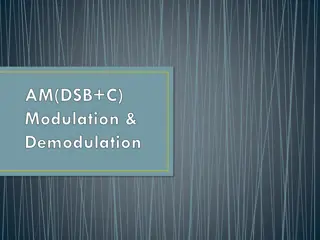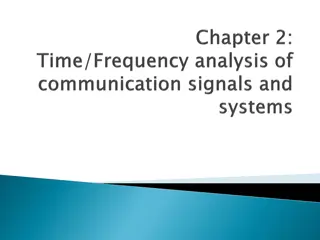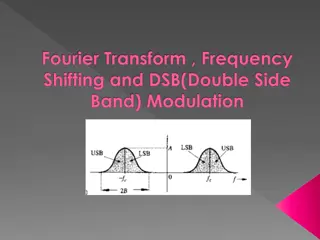Nonblocking and Signal-Driven I/O
This comprehensive guide explores the concepts of blocking vs. non-blocking I/O, nonblocking input/output/accept/connect operations, signal-driven I/O, and steps to implement it. Learn about TCP/UDP operations, accepting new connections, initiating outgoing connections, and making sockets nonblocking with code examples. Explore the differences between blocking and nonblocking I/O operations and their implications in programming.
Download Presentation

Please find below an Image/Link to download the presentation.
The content on the website is provided AS IS for your information and personal use only. It may not be sold, licensed, or shared on other websites without obtaining consent from the author.If you encounter any issues during the download, it is possible that the publisher has removed the file from their server.
You are allowed to download the files provided on this website for personal or commercial use, subject to the condition that they are used lawfully. All files are the property of their respective owners.
The content on the website is provided AS IS for your information and personal use only. It may not be sold, licensed, or shared on other websites without obtaining consent from the author.
E N D
Presentation Transcript
Nonblocking and Signal Driven I/O Blocking vs. non-blocking I/O Nonblocking input, output, accept, and connect Concepts and steps for using signal-driven I/O UDP echo server using signal-driven I/O Readings UNP Section 6.2, CH16, Ch25 1
Blocking vs. Nonblocking I/O Blocking I/O When an operation cannot be completed immediately, the process is put into sleep Nonblocking I/O When an operation cannot be completed immediately, the function return immediately with an error, so the process can proceed accordingly (e.g. elect to do something else). Default I/O operations are all blocking Non-blocking IO has implications on input, output, accept, and connect. 2
Input Operations Functions read, recvfrom, readv, recv, recvmsg Blocking socket TCP: sleep until some data arrives UDP: sleep until a UDP datagram arrives Nonblocking socket Return immediately with an error EWOULDBLOCK, if no data in receive buffer 3
Output Operations Functions write, sendto, writev, send, and sendmsg Blocking socket TCP: sleep until room is available in send buffer UDP: does not have socket send buffer. A process can be blocked due to buffering etc in protocol stack. Nonblocking socket TCP: return immediately with an error EWOULDBLOCK, if no room in send buffer UDP: send operation cannot be completed due to various reasons 4
Accepting New Connections Function accept Blocking socket Sleep until some new connections available Nonblocking socket Return immediately with an error EWOULDBLOCK, if no new connection is available 5
Initiating Outgoing Connections Function connect (for TCP) Blocking socket Sleep until ACK is received for SYN packet. Nonblocking socket Return immediately with an error of EINPROGRESS, if connection cannot be established immediately Note that a connection may be established immediately 6
Making Socket Nonblocking File control function #include <fcntl.h> int fcntl(int fd, int cmd, /* int arg */) cmd: F_GETFL and F_SETFL flag = fcntl(sockfd, F_GETFL, 0); fcntl(sockfd, F_SETFL, flag | O_NONBLOCK); I/O control function #include <sys/ioctl.h> int ioctl(int fd, int request, ) Request: FIONBIO int on = 1 ioctl(sockfd, FIONBIO, (char *)&on); 7
How to Handle Nonblocking I/O A nonblocking function returns immediately, what s next? Choice 1: Do some other things A program may not have other things to do Choice 2: keeping on polling until success Waste system resources Choice 3: blocking somewhere until some operation can be performed select() function 8
Select and Nonblocking I/O When is a socket ready for nonblocking I/O? When data arrives in receive buffer, it is ready for read When room is available in send buffer, it is ready for write For server side (accept), when a new connection is available, it is ready for both read and write For client side (connect), when a connection is established, it is ready for write; when a connection cannot be established, it is ready for both read and write So how you know if a connection has been established successfully or not getsockopt to retrieve SO_ERROR (0 -> success) 9
Blocking and Nonblocking Echo Client Blocking echo client echo_client_select.cpp Nonblocking echo client echo_client_nonblocking.cpp 10
Pros and Cons of Nonblocking I/O Advantage More control, possibly higher performance Disadvantages Much more complicated Buffer needs to be maintained by application program if message needs to be forwarded from one socket to another Cannot guarantee all writes complete Other complications like connect Use concurrent and multiplexed design instead of nonblocking I/O, if possible 11
Motivation Efficiently detecting an asynchronous event (arrival of a connection, arrival of a message, etc) is difficult. Blocking IO: can block for a long time Nonblocking IO: do not block for a long time, but must keep polling tedious How do we deal with other types of asynchronous events? E.g. input from keyboard? Using interrupt Corresponding to this, we have signal driven IO 13
Signal-driven I/O The kernel raises a signal (SIGIO) when something happens to a file descriptor Three steps to use signal-driven I/O with sockets Establish a signal handler for SIGIO Functions signal/sigaction Set the socket owner fcntl with command F_SETOWN Enable signal-driven I/O for the socket fcntl with command O_SETFL (turn on O_ASYNC) ioctl with request FIOASYNC 14
Set Socket Owner Function fcntl with command F_SETOWN fcntl(int fd, int cmd, /* int arg*/) Set process ID or process group ID to receive SIGIO and SIGURG signals Arg > 0: process ID == arg Arg < 0: process group ID == |arg| fcntl(sockfd, F_SETOWN, getpid()); 15
Enable Signal-Driven I/O for Socket Function fcntl with command F_SETFL Turn on O_ASYNC int flag; flag = fcntl(sockfd, F_GETFL, 0); fcntl(sockfd, F_SETFL, flag | O_ASYNC); Function ioctl with request FIOASYNC int on = 1; ioctl(sockfd, FIOASYNC, &on); 16
Complication of Signal-Driven I/O Signals are not queued when they are blocked When SIGIO is blocked, at most one SIGIO signal will be pending even if two pieces of data arrive No one to one mapping between number of signals and arrived data In handler of SIGIO, we need to handle all arriving data Read until there is no data (how?) Nonblocking I/O needs to be used with signal-driven I/O 17
When is SIGIO raised? For UDP sockets A datagram arrives An error occurs For TCP sockets A connection request has completed A disconnect request has been initiated A disconnect request has completed Half of a connection has been shut down Data has arrived Data has been sent Too many SIGIOs for a TCP socket rarely used listening socket 18
Echo Server with Signal-Driven I/O Examples udp_echo_server.cpp and udp_echo_client.cpp A particular use of signal-driven I/O is NTP (network time protocol) Time sensitive. A server needs to record the accurate arrival time of a datagram and return to client. 19
Summary of I/O models Blocking Nonblocking Multiplexed Signal driven Asynchronous 20
Blocking IO 21
